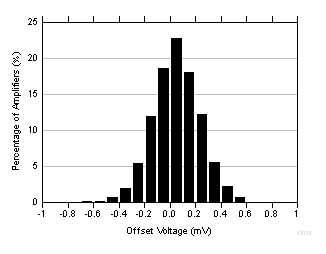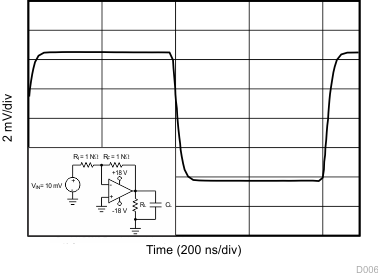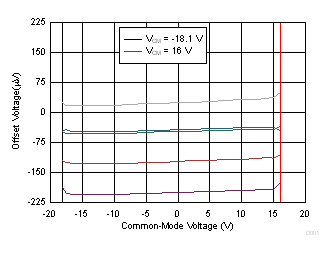JAJSCL5C November 2016 – January 2019 TLV172 , TLV2172 , TLV4172
PRODUCTION DATA.
- 1 特長
- 2 アプリケーション
- 3 概要
- 4 改訂履歴
- 5 Device Comparison Table
- 6 Pin Configuration and Functions
- 7 Specifications
- 8 Detailed Description
- 9 Application and Implementation
- 10Power Supply Recommendations
- 11Layout
- 12デバイスおよびドキュメントのサポート
- 13メカニカル、パッケージ、および注文情報
パッケージ・オプション
メカニカル・データ(パッケージ|ピン)
サーマルパッド・メカニカル・データ
発注情報
7.8 Typical Characteristics
at VS = ±18 V, VCM = VS / 2, RLOAD = 10 kΩ connected to VS / 2, and CL = 100 pF (unless otherwise noted)Table 1. Characteristic Performance Measurements
| DESCRIPTION | FIGURE |
|---|---|
| Offset Voltage Production Distribution | Figure 1 |
| Offset Voltage vs Common-Mode Voltage | Figure 2 |
| Offset Voltage vs Common-Mode Voltage (Upper Stage) | Figure 3 |
| Input Bias Current vs Temperature | Figure 4 |
| Output Voltage Swing vs Output Current (Maximum Supply) | Figure 5 |
| CMRR and PSRR vs Frequency (Referred-to-Input) | Figure 6 |
| 0.1-Hz to 10-Hz Noise | Figure 7 |
| Input Voltage Noise Spectral Density vs Frequency | Figure 8 |
| Quiescent Current vs Supply Voltage | Figure 9 |
| Open-Loop Gain and Phase vs Frequency | Figure 10 |
| Closed-Loop Gain vs Frequency | Figure 11 |
| Open-Loop Output Impedance vs Frequency | Figure 12 |
| Small-Signal Overshoot vs Capacitive Load | Figure 13, Figure 14 |
| No Phase Reversal | Figure 15 |
| Small-Signal Step Response (10 mV) | Figure 16, Figure 17 |
| Large-Signal Step Response | Figure 18, Figure 19 |
| Large-Signal Settling Time | Figure 20, Figure 21 |
| Short-Circuit Current vs Temperature | Figure 22 |
| Maximum Output Voltage vs Frequency | Figure 23 |
| EMIRR IN+ vs Frequency | Figure 24 |

| Distribution taken from 5185 amplifiers |

| 5 typical units shown, VS = ±18 V |
(Upper Stage)





| 100-mV output step, G = –1 | ||


| RL = 1 kΩ | CL = 10 pF | 10-mV step |

| RL = 1 kΩ | CL = 10 pF |

| 10-V negative step | G = 1 | CL = 10 pF |


| 5 typical units shown, VS = ±18 V |




| CLOAD = 15 pF |


| 100-mV output step, G = 1 | ||

| CL = 10 pF | 10-mV step |

| CL = 10 pF |

| 10-V positive step | G = 1 | CL = 10 pF |


| PRF = –10 dBm | VSUPPLY = ±18 V | VCM = 0 V |